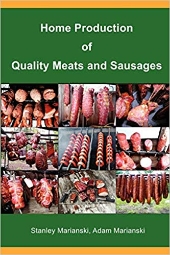Erwin Decoene wrote:
If the absence of nitrates and nitrites is your concern - these are new additives. Meat, fish, and other foods have been preserved for millenia without nitrates/nitrites. Nitrite binds to metals !!!
If i am not mistaken nitrates are mainly used to maintain a nice rosy colour.
Using Nitrites and nitrates is historically normal (what's new is the understanding of what sodium nitrite and sodium nitrate is). A person don't have to use nitrites/nitrates to cure meat. But, in the past these salts were frequently used to cure meat.
Nitrites/nitrates have been used by humans to cure meat for thousands of years. They are not necessary, but they do provide an additional measure of safety, taste, and as you say, colour. In the past these curing salts were from vegetable sources and/or saltpeter. Saltpeter is most common in Europe. The big problem with saltpeter in history is the amount of nitrate/nitrite in it was unknown, so people would often use far more than we do today. Looking back as recently as 100 years ago, the amount of nitrite/nitrate used in curing meat is shocking by todays standards. Medieval and Roman recipe books both call for massive amounts of curing salt. Likewise, a few archaeological finds include cured meats, which were cured with nitrite/nitrates.
It's good to remember that for most of human history salt was a luxury item. Even if you lived by the sea or near a salt mine, salt production was often heavily controlled by local officials... depending on when and where you are in history, and salt was hard to come by. If you lived inland and away from salt mines, then you had to depend on trade to get your salt. To reduce the amount of salt used, people used things like saltpeter in their meat curing. There are other reasons for doing it too, but this is one of the more common ones.
The curing salts we use these days are historical unusual because they contain so little nitrate/nitrite.
There are plenty of ways to work without curing salts, one of them is to increase the amount of regular salt you use.







































 1
1





















